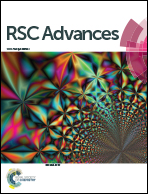Porous carbon adsorption layer enabling highly reversible redox-reaction of a high potential organic electrode material for sodium ion batteries†
Abstract
Organic compounds have been utilized in rechargeable batteries as electrode materials on account of their designable structures and reversible redox properties. However, most of them suffer from problems with dissolution resulting in poor electrochemical performance. In this work, we adapt a sodium salt of tetracyanoquinodimethane (NaTCNQ) to work as a high redox potential cathode material in sodium ion batteries (SIBs). A porous carbon coated separator is demonstrated to be an adsorption layer and prevents the dissolved active material from migrating to the anode side. The NaTCNQ cell assembled with a carbon layer containing 5% activated carbon (AC) exhibits a higher initial capacity and greatly improved cycling stability. Using a conductive adsorption layer in organic redox batteries is a promising pathway to develop high performance organic electrode materials for SIBs.



 Please wait while we load your content...
Please wait while we load your content...